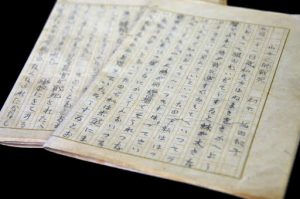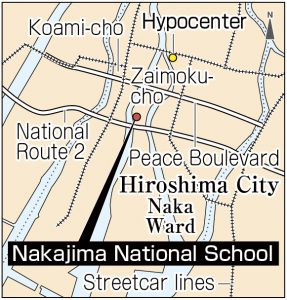Seventy-six years after war’s end: Essay composed at Nakajima National School by A-bomb victim Kazuko Sakata regarded as written artifact
Jun. 2, 2021
Shadow of war evident in energetic girl’s essay
by Junji Akechi, Staff Writer
The faded brown manuscript reads, “I was thinking we would never be defeated by the United States and the United Kingdom.” The document, recorded in halting handwriting, shows the writer’s childlike resolve in wartime. The essay was written by Kazuko Sakata, then a sixth-grade student at Nakajima National School (now Nakajima Elementary School, located in Hiroshima’s Naka Ward), in 1943. Ms. Sakata was describing her feelings as she heard the news on the radio that Isoroku Yamamoto, the Japan combined fleet’s Commander, had died in battle.
Ms. Sakata was a member of a girls’ class taught by Kotaro Kawaguchi, a former teacher at the school. The following spring, she entered Aki Girls’ High School (later, the school closed down). On August 6, 1945, she was mobilized for the work of dismantling buildings to create fire lanes around the area of Koami-cho (now part of Naka Ward), located about 900 meters from the hypocenter. Her remains have never been found.
“Kazuko was strong-minded and energetic. She often came to our house to eat, and my mother was very fond of her,” said Machiko Morisawa, 84, Ms. Sakata’s cousin and a resident in the area of Koda in Kochi City, as she reminisced about gatherings they had before the atomic bombing. Both Ms. Sakata’s home and Ms. Morisawa’s home were located on the same street in the neighborhood of Zaimoku-cho, which is present-day Hiroshima Peace Memorial Park, in the city’s Naka Ward.
Both the brothers Juichi Sakata—Ms. Sakata’s father—and Masaichi Sakata—Ms. Morisawa’s father—were killed in the atomic bombing. The two had been unable to evacuate from Hiroshima City because they operated a clothing shop together.
Ms. Morisawa, who was then a second-grade student at the national school, evacuated to a suburb of Hiroshima that is now part of the city’s Asakita Ward. Two days after the atomic bombing, she returned to the remains of her home. “There were no traces at all of either my own house or the main family house (Ms. Sakata’s home). I found only water pouring from a water pipe.”
Ms. Morisawa regrets her lack of memory about holding a decent funeral for Kazuko, because both families had lost their father. There were no mementos, either. Responding to the news that Kazuko’s essay was found after nearly 80 years, she said, “I wonder if Kazuko might be hoping to return to us. I feel as if I ought to pray for her again.”
The newspaper’s continuing investigation also led to our discovering that another essay writer in Mr. Kawaguchi’s class was still alive. Setsuko Yamamoto (née Obara), 89, a resident of Hiroshima’s Nishi Ward, recalled her teacher’s personality. “From my perspective as a child, he was a good teacher who always thought of his students,” said Ms. Yamamoto, after she was informed that he had kept his students’ essays at his home.
Ms. Yamamoto’s family ran a confectionary company at their home in the neighborhood of Yoshijima-hagoromo-machi (now part of Hiroshima’s Naka Ward), but everything was burned to the ground in the atomic bombing. She said, “It’s still incomprehensible to me how my family managed to make a living after the war.” Her older sister had evacuated with her to the suburbs, but she experienced the atomic bombing while on her way back from a hospital in the city of Hiroshima. She died four days after the bombing. Ms. Yamamoto also lost her cousin and classmates at her girls’ school. She underwent the losses and struggled through a tough restart to life from the barracks where she had to live.
Ms. Yamamoto’s essay reads, “We are blessed with good sunlight, and there is a beautiful river in Hiroshima with ducks swimming around sometimes.” Looking at her childhood essay, Ms. Yamamoto murmured, “That girl doesn’t remind me of myself.” The pre-bombing scenes she described with her unsophisticated handwriting was too serene when compared against the tragedy she was forced to endure later.
(Originally published on June 2, 2021)









